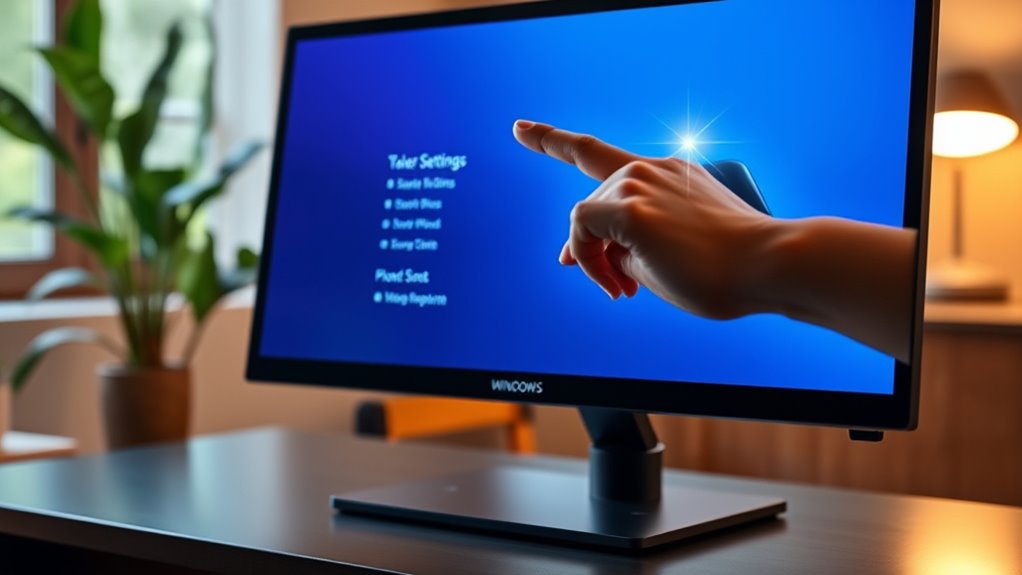To temporarily disable your touchscreen monitor on Windows, start by right-clicking the Start button and selecting Device Manager. Expand the “Human Interface Devices” section, find your touchscreen device, and right-click it. Choose “Properties,” go to the “Driver” tab, and click “Disable Device.” Confirm your choice. If you need to re-enable it later, follow the same steps and select “Enabled.” For even more control over touch input settings, you may want to explore additional options.
Understanding the Need to Disable Touchscreen
Sometimes, you might find that disabling your touchscreen monitor is necessary for a smoother computing experience. While touchscreen advantages, like intuitive navigation and quick access to apps, enhance usability, they can also present drawbacks. Accidental touches can disrupt your workflow, especially when you’re typing or using precise applications. If you’re working on detailed tasks or simply prefer a traditional mouse and keyboard setup, turning off the touchscreen can help maintain focus and reduce frustration. Disabling it gives you control over how you interact with your device, allowing for a more tailored experience. Understanding when to disable your touchscreen can ultimately lead to a more efficient and enjoyable computing environment, allowing you the freedom to work as you prefer.
Accessing Device Manager
To disable your touchscreen monitor, you’ll first need to access the Device Manager, an essential tool in Windows that allows you to manage hardware devices. You can find it by right-clicking on the Start menu and selecting “Device Manager.” Once there, you’ll have access to various device settings, including your touchscreen.
Here’s a quick reference table for maneuvering Device Manager:
| Step | Action |
|---|---|
| Step 1 | Right-click on the Start menu |
| Step 2 | Select “Device Manager” |
| Step 3 | Locate your touchscreen device |
After accessing Device Manager, you’ll be ready to adjust touchscreen calibration or disable the device as needed. Enjoy your freedom to customize your settings!
Disabling the Touchscreen Driver
Once you’ve located your touchscreen device in Device Manager, disabling the touchscreen driver is a straightforward process. First, right-click on the device and select “Properties.” In the driver properties window, navigate to the “Driver” tab. Here, you’ll find an option to disable the driver. Click on “Disable Device,” and confirm your choice. This action will prevent the touchscreen from responding to any inputs, effectively altering your touchscreen settings. If you’re looking for more freedom while using your device, this is a quick way to regain control. Remember, you can always re-enable the driver later if needed. For now, enjoy your non-touch experience without any interruptions!
Re-enabling the Touchscreen
If you decide you want to restore touchscreen functionality, re-enabling the driver is a simple task. Start by opening the Device Manager—just right-click the Start button and select it. In Device Manager, expand the “Human Interface Devices” section. You’ll find your touchscreen device listed there. Right-click it and select “Enable device.” This action will reactivate the touchscreen, allowing you to enjoy its benefits once again. If you run into any issues, don’t hesitate to engage in some touchscreen troubleshooting. Restart your computer if necessary, as this can often resolve any lingering problems. With these steps, you’ll quickly regain the freedom and convenience that a touchscreen provides for your daily tasks.
Alternative Methods to Disable Touch Input
While disabling the touchscreen through Device Manager is straightforward, there are alternative methods you can use to achieve the same result. One option is to access the touchscreen settings directly in Windows. Go to Settings > Devices > Pen & Windows Ink, where you can adjust input methods and turn off touch input temporarily. Another approach is to use a third-party application designed to manage touchscreen functionality. These apps often provide quick toggles that let you disable touch input with a single click. If you’re using a tablet mode, simply switching to desktop mode can also help, as it may limit touch interactions. Choose the method that best suits your needs for a more controlled experience.
Frequently Asked Questions
Will Disabling the Touchscreen Affect Other Functionality?
Disabling the touchscreen won’t affect other functionality, but it’ll limit your interaction options. Depending on your user preferences, you might find it more convenient to use a mouse or keyboard for navigation instead.
Can I Disable the Touchscreen Permanently?
Yes, you can disable the touchscreen permanently through device settings. For example, if you’re using a drawing tablet, disabling the touchscreen can enhance your precision and focus, providing a permanent solution for an uninterrupted experience.
How Do I Re-Enable the Touchscreen if It Doesn’t Work?
To re-enable your touchscreen, check device settings for any disabled options. If it’s still unresponsive, try touchscreen troubleshooting steps like updating drivers or restarting your device to restore functionality.
Is There a Keyboard Shortcut to Disable the Touchscreen?
There isn’t a universal keyboard shortcut to disable your touchscreen. However, you can quickly access touchscreen settings through Device Manager. Think of it like opening a door—freedom comes with a few extra steps!
Will This Process Void My Warranty?
No, temporarily disabling your touchscreen shouldn’t void your warranty. However, always check your device’s warranty implications and guarantee you’re following proper touchscreen maintenance to avoid any potential issues. You want to keep your device protected.

